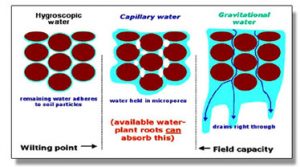How plants take up water

Why do plants need water?
We all know that plants need water – but why? Here are the top four reasons:
- Plants need water in order to stand up. Some will eventually make woody tissue to help this process, but basically plants are full of pressurised water which makes them turgid. The leaves offer themselves to the sun – their stomata (pores) open – moisture evaporates. Water is drawn upward from the roots and through the stems to replace this lost water. This process is called evapotranspiration. The more sun, the greater the pressure to take up water. This process takes energy from the plant, and obviously requires a healthy root system and the presence of available water in the root zone. If it’s not there, the plant will wilt. In cases of root disease and diseases like Fusarium, you will see whole crops crash down.
- Plants need water to carry nutrients into themselves. These are dissolved in the soil water. They can’t munch on dry fertiliser. No passage of water into the plant and no nutrient uptake. If the plant can’t take up water, it will become starved of nutrients. It’s not so uncommon to see high nutrient soils and pale, nutrient-starved crops because of an inability of the plant to take up water.
- Plants need water to photosynthesize. To summarise a fairly complex process, photosynthesis is the synthesis of sugar (energy) from light, carbon dioxide and water, with oxygen as a by-product. Take away any of those factors, and the plant won’t grow. It has no energy.
- Plants need oxygen in the root zone. Like all aerobic organisms (including us), they need to respire as part of the process of utilising the sugars they created in photosynthesis, and this requires oxygen. No oxygen, no respiration. No respiration, no functionality. The roots can’t grow – and can’t take up water – and can’t supply the plant with the nutrients and water that it needs. This is why we talk about a plant needing drainage. The problem in a waterlogged situation is not too much water – it’s too little oxygen.
Water in the soil
Soil is made up of soil particles in crumb-form (peds), and pore spaces around the soil crumbs. In a well-structured soil, these crumbs are nice and stable. But in a poorly structured soil, the crumbs are unstable which often limits pore-space. The pore-spaces are necessary for holding water, and for the free gaseous exchange of oxygen and carbon dioxide between the plant roots and the soil surface (respiration process).
There are three types of soil water:
- Gravitational water. This is the water which is susceptible to the forces of gravity. It exists after significant rainfall, and after substantial irrigation. This is the water that fills all the pore-space and leaves no room for oxygen and gaseous exchange. In light soils, this tends to drain away quickly. In heavy soils, this can take time.
- Capillary water. This is the water which is held with the force of surface tension by the soil particles and is resistant to the forces of gravity. This is the water that is present after the gravitational water has drained away, leaving spaces free for gaseous exchange. When the soil is holding its maximum capillary water (after the gravitational water has drained), this is called field capacity. At this point, the plant is able to take up water easily, and has the oxygen that it needs in the root zone.
- Hygroscopic water. This is the water that is held so tightly (by surface tension) to the soil particles that the plant roots can’t take it up. It’s there – but it’s unavailable. At this stage there’s generally sufficient oxygen, but there just isn’t enough available water. The plant wilts and eventually dies if it doesn’t get water. When the plant wilts and is unable to recover, this is called the permanent wilting point.

Now, a lot happens between field capacity and permanent wilting point. This is the key point:
The closer to the soil particle the water is held, the tighter it’s held. And the further from the particle, the looser it’s held. It takes little energy for the plant roots to take up the water that’s far from the particle and is present at the field capacity point. By contrast, as the water is used up (or evaporates), it takes more and more energy for the plant to take up water.
For example, think about how you drink through a straw. A short straw in a cup that is 15cm away from you is easy to use. A one-metre long straw takes a lot of energy to suck up a drink. A twenty-metre straw is impossible to use. It works much the same with plants. The more the soil dries out, the more energy the plant needs to output in order to get a decent drink.
GrowFlow and GoFlow magnetic water conditioners. An environmentally safe and powerful way to treat water. Shop now >